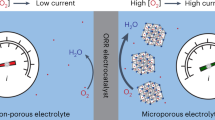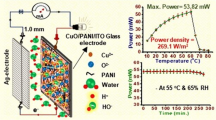Abstract
Based on the example of a nanopowder system ZrO2–3% mol Y2O3 with atmospheric humidity interaction, the possibility of exothermic heterophase electrochemical energy conversion to electric energy is shown. Electrical properties and structure of the experimental sample were studied under gradient molecular flux density of humidity during sample saturation. The idea of development of the novel chemo-electronic converter device based on nanoscale dielectrics as ZrO2–3% mol Y2O3 is proposed.







Similar content being viewed by others
References
Alekseenko VI, Volkova GK (1999) Adsorption mechanism of phase transformation in stabilized zirconia. J Tech Phys 70:57–62
Doroshkevich AS, Danilenko IA, Konstantinova TE (2006) Diagnostics of nanopowder systems based on zirconia by transmission electron microscopy. Electron Microsc Strength Mat 13:151–159
Doroshkevich AS, Lyubchyk AI, Islamov AK (2017a) Nonequilibrium chemo-electronic conversion of water on the nanosized YSZ: experiment and molecular dynamics modelling problem formulation. J Phys Conf Ser 848(012021):1–9. https://doi.org/10.1088/1742-6596/848/1/012021
Doroshkevich AS, Lyubchik AI, Shilo AV (2017b) The effect of chemo-electronic energy conversion in nanopowder systems based on zirconia. Surf X-Ray Synchrotron Neutron Stud 11(3):523–529. https://doi.org/10.1134/S1027451017030053
Gergen B, Nienhaus H, Henry Weinberg W, Mc Farlandand EW (2001) Chemically induced electronic excitations at metal surfaces. Science 294:2521–2523. https://doi.org/10.1126/science.1066134
Gurvich LV, Karachevtsev GV, Kondratiev VN et al (1974) Breaking energies of chemical bonds, ionization potentials and electron affinity. Sci Moscow 351:276
Kabansky AY, Styrov VV (2004) A new means of chemical energy conversion by semiconductor. In: Chandra D, Bautista RG, Shlapbach L (eds) Adv Mat for energy conversion II. TMS, Charlotte, pp 43–52
Kabansky AY, Styrov VV, Tyurin YI (1979) On the possibility of direct conversion of chemical energy into electrical energy on semiconductors. Lett ZhTF 5:833–836
Kammler Th, Kuppers J (1999) Interaction of H atoms with Cu(111) surfaces: adsorption, absorption, and abstraction. J Chem Phys 111:8117. https://doi.org/10.1063/1.480145
Konstantinova ТЕ, Volkova GK, Danilenko IA (1996) Features of the tetragonally monoclinic transformation in the surface layers of the ceramics of the ZrO2-Y2O3 system. PHPT 6:9–19
Konstantinova T, Danilenko I, Glazunova V, Volkova G, Gorban O (2011) Mesoscopic phenomena in oxide nanoparticles systems: processes of growth. J Nanopart Res 13:4015–4023. https://doi.org/10.1007/s11051-011-0329-8
Ma M, Guo L, Anderson DG, Langer R (2013) Bio-inspired polymer composite actuator and generator driven by water gradients. Science 339:186–189. https://doi.org/10.1126/science.1230262
Miljkovic N, Preston DJ, Enright R, Wang EN (2014) Jumping-droplet electrostatic energy harvesting. Appl Phys Lett 105:013111. https://doi.org/10.1063/1.4886798
Muller J, Rech B, Springer J (2004) TCO and light trapping in silicon thin film solar cells. Sol Energy 70:917. https://doi.org/10.1016/j.solener.2004.03.015
Naumov II, Olkhovsky GA, Velikokhatny OI, Aparov NN (1993) The mechanism of stabilization of the cubic phase Zr02.. Solid State Phys 35:1089–1091
Okamoto Y (2008) First-principles molecular dynamics simulation of O2 reduction on ZrO2 (111) surface. Appl Surf Sci 255:3434–3441. https://doi.org/10.1016/j.apsusc.2008.09.061
Oksengendler BL, Turaeva NN (2010a) Surface tamm states at curved surfaces of ionic crystals. Dokl Phys 434:609
Oksengendler BL, Turaeva NN (2010b) Surface tamm states at curved surfaces of ionic crystals. Dokl Phys 55:477–479
Oksengendler BL, Askarov B, Nikiforov VN (2014) Role of electron confinement in the formation of Tamm surface levels in nanoparticles. ZhTF 84:156
Oksengendler BL, Nikiforov VN, Maksimov SE (2017) Tamm states of fractal surfaces. Rep Acad Sci 744(4):423–426. https://doi.org/10.7868/S0869565217040053
Oksengendler BL, Maksimov SE, Nikiforov VN (2018) Surf X-Ray Synchrotron Neutron 2:68–73 https://doi.org/10.7868/S0207352818020117
Ptitsyn VE (2007) Anomalous thermal field emission. ZhTF 77(4):113–118
Styrov VV, Simchenko SV (2012) High-efficiency generation of electron–hole pairs on a selenium p–n junction under the action of atomic hydrogen. ZhTF Lett 96:343–346
Styrov VV, Simchenko SV (2013) Generation of chemo-EMF in a nanoscale pn-junction based on SiC. Rep Natl Acad Sci Ukraine 5:80–86
Styrov VV, Tyurin YI (2003) Nonequilibrium chemoeffects on the surface of solids. Energoatomizdat, Moscow
Styrov VV, Simchenko SV, Golotyuk VN (2011) Chemo-EMF in the silicon solar cell exposed to low-energy hydrogen atoms. Nanomat Appl Prop 2(1):85–91
Subhoni M, Kholmurodov K, Doroshkevich A, Asgerov E et al (2018) Density functional theory calculations of the water interactions with ZrO2 nanoparticles Y2O3 doped. J Phys Conf Ser 994:012013. https://doi.org/10.1088/1742-6596/994/1/012013
Tyurin YI, Horuzhy VD, Shigalugov, SK et al (2008) Efficiency of transmission of energy of adsorption and recombination of atoms to the solid body at different mechanisms of excitation. News Tomsk Pol Univ 312:56–65
Wert C, Thomson R (1969) Solid state physics. Mir, Moscow, p 280
Zainullina VN, Zhukov VP et al (2000) Electronic structure and ion characteristics conductivity in zirconium dioxide, stabilized calcium and yttrium impurities. Zh Strukt Khim 41(2):229–239
Zheng L, Ma Y, Chu S (2014) Improved light absorption and charge transport for perovskite solar cells with rough interfaces by sequential deposition. Nanoscale 6:8171. https://doi.org/10.1039/c4nr01141d
Acknowledgements
The authors thank Dr. R.G. Nazmitdinov (JINR), Dr Y.B. Martynov and Dr. P.P. Gladyshev from Dubna State University, Dr N.A. Poklonsky (BSU) for discussion results. Results presented here received funding from the European Union Horizon 2020 research and innovation program under the Marie Sklodovska Curie Actions Grant agreement 691010, also JINR-Romania Cooperation Programme Project of 2018 Order no. 323/65, Project No. 323/21.05.2018 item 68 and RFBR Grant no. 17-52-45062.
Author information
Authors and Affiliations
Contributions
DAS—analysis of the results, preparation of the manuscript, development of the empirical mechanism of the chemo-electronic conversion effect. AEB—XRD experiment, mathematical processing of results, discussion of experimental results. ShAV—engineering of chemo-electronic device, preparing a manuscript, discussing the results of the experiment. LAI—SEM research of the samples, discussion of the experimental results. LAI—conducting electrical studies of samples, discussion of experimental results. GVA—TEM research samples, discussion of the experimental results. IAKh—comprehensive analysis of the results, analysis of the mechanism of the chemo-electronic conversion effect from the standpoint of the theory of polymolecular adsorption. TVA—XRD research of samples in vacuum, discussion of the results of the experiment. AV—comprehensive analysis of the results, discussion of the mechanisms of charge delivery to the electrodes. LD—comprehensive analysis of the results, discussion of the mechanisms of electron emission and charge delivery to electrodes. BM—development of an empirical mechanism for the effect of chemo-electronic conversion. DVS—production of nanopowders, development of methods for obtaining working suspensions for chemo-converters, discussion of the mechanism of the effect of chemo-electronic conversion from the standpoint of the theory of interfacial catalysis. MAI—conduct a literature review, discuss the results of the experiment experiment from the standpoint of physical chemistry. KKT—discussion of the mechanism of delivery of charge carriers to the electrodes from the standpoint of molecular dynamics. BVI—discussion of the mechanism of the chemo-electronic conversion effect as from the standpoint of the theory of catalysis on the surface of semiconductors, discussion of the results of the experiment. OBL—discussion of the empirical mechanism of the effect of chemo-electron conversion from the standpoint of band theory and the theory of nanofractality, discussion of the results of the experiment.
Corresponding author
Ethics declarations
Conflict of interest
The authors declare that they have no competing interests.
Additional information
Publisher’s Note
Springer Nature remains neutral with regard to jurisdictional claims in published maps and institutional affiliations.
Rights and permissions
About this article
Cite this article
Doroshkevich, A.S., Asgerov, E.B., Shylo, A.V. et al. Direct conversion of the water adsorption energy to electricity on the surface of zirconia nanoparticles. Appl Nanosci 9, 1603–1609 (2019). https://doi.org/10.1007/s13204-019-00979-6
Received:
Accepted:
Published:
Issue Date:
DOI: https://doi.org/10.1007/s13204-019-00979-6




